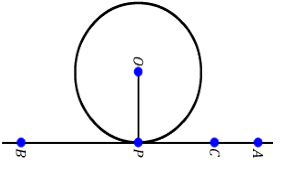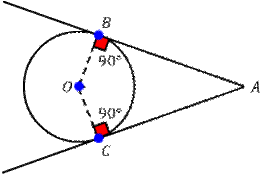Scroll:Theorem: >> Theorem >> saq (4155)
Written Instructions:
For each Multiple Choice Question (MCQ), four options are given. One of them is the correct answer. Make your choice (1,2,3 or 4). Write your answers in the brackets provided..
For each Short Answer Question(SAQ) and Long Answer Question(LAQ), write your answers in the blanks provided.
Leave your answers in the simplest form or correct to two decimal places.
| 1) 1. Summary Point of contact: Some properties of tangents to a circle: Infinite number of tangents can be drawn to a circle but only one tangent can be drawn at any given point on a circle.
Theorem:
Given: A tangent AB with point of contact P. Theorem: Given: Two tangents AB and AC from an external point A to points B and C on a circle. Answer:_______________ |
| 2) 1. Summary Point of contact: Some properties of tangents to a circle: Infinite number of tangents can be drawn to a circle but only one tangent can be drawn at any given point on a circle.
Theorem:
Given: A tangent AB with point of contact P. Theorem: Given: Two tangents AB and AC from an external point A to points B and C on a circle. Answer:_______________ |
| 3) 1. Summary Point of contact: Some properties of tangents to a circle: Infinite number of tangents can be drawn to a circle but only one tangent can be drawn at any given point on a circle.
Theorem:
Given: A tangent AB with point of contact P. Theorem: Given: Two tangents AB and AC from an external point A to points B and C on a circle. Answer:_______________ |
| 4) 1. Summary Point of contact: Some properties of tangents to a circle: Infinite number of tangents can be drawn to a circle but only one tangent can be drawn at any given point on a circle.
Theorem:
Given: A tangent AB with point of contact P. Theorem: Given: Two tangents AB and AC from an external point A to points B and C on a circle. Answer:_______________ |
| 5) 1. Summary Point of contact: Some properties of tangents to a circle: Infinite number of tangents can be drawn to a circle but only one tangent can be drawn at any given point on a circle.
Theorem:
Given: A tangent AB with point of contact P. Theorem: Given: Two tangents AB and AC from an external point A to points B and C on a circle. Answer:_______________ |
| 6) 1. Summary Point of contact: Some properties of tangents to a circle: Infinite number of tangents can be drawn to a circle but only one tangent can be drawn at any given point on a circle.
Theorem:
Given: A tangent AB with point of contact P. Theorem: Given: Two tangents AB and AC from an external point A to points B and C on a circle. Answer:_______________ |
| 7) 1. Summary Point of contact: Some properties of tangents to a circle: Infinite number of tangents can be drawn to a circle but only one tangent can be drawn at any given point on a circle.
Theorem:
Given: A tangent AB with point of contact P. Theorem: Given: Two tangents AB and AC from an external point A to points B and C on a circle. Answer:_______________ |
| 8) 1. Summary Point of contact: Some properties of tangents to a circle: Infinite number of tangents can be drawn to a circle but only one tangent can be drawn at any given point on a circle.
Theorem:
Given: A tangent AB with point of contact P. Theorem: Given: Two tangents AB and AC from an external point A to points B and C on a circle. Answer:_______________ |
| 9) 1. Summary Point of contact: Some properties of tangents to a circle: Infinite number of tangents can be drawn to a circle but only one tangent can be drawn at any given point on a circle.
Theorem:
Given: A tangent AB with point of contact P. Theorem: Given: Two tangents AB and AC from an external point A to points B and C on a circle. Answer:_______________ |
| 10) 1. Summary Point of contact: Some properties of tangents to a circle: Infinite number of tangents can be drawn to a circle but only one tangent can be drawn at any given point on a circle.
Theorem:
Given: A tangent AB with point of contact P. Theorem: Given: Two tangents AB and AC from an external point A to points B and C on a circle. Answer:_______________ |
| 1) 1. Summary Point of contact: Some properties of tangents to a circle: Infinite number of tangents can be drawn to a circle but only one tangent can be drawn at any given point on a circle.
Theorem:
Given: A tangent AB with point of contact P. Theorem: Given: Two tangents AB and AC from an external point A to points B and C on a circle. |
| 2) 1. Summary Point of contact: Some properties of tangents to a circle: Infinite number of tangents can be drawn to a circle but only one tangent can be drawn at any given point on a circle.
Theorem:
Given: A tangent AB with point of contact P. Theorem: Given: Two tangents AB and AC from an external point A to points B and C on a circle. |
| 3) 1. Summary Point of contact: Some properties of tangents to a circle: Infinite number of tangents can be drawn to a circle but only one tangent can be drawn at any given point on a circle.
Theorem:
Given: A tangent AB with point of contact P. Theorem: Given: Two tangents AB and AC from an external point A to points B and C on a circle. |
| 4) 1. Summary Point of contact: Some properties of tangents to a circle: Infinite number of tangents can be drawn to a circle but only one tangent can be drawn at any given point on a circle.
Theorem:
Given: A tangent AB with point of contact P. Theorem: Given: Two tangents AB and AC from an external point A to points B and C on a circle. |
| 5) 1. Summary Point of contact: Some properties of tangents to a circle: Infinite number of tangents can be drawn to a circle but only one tangent can be drawn at any given point on a circle.
Theorem:
Given: A tangent AB with point of contact P. Theorem: Given: Two tangents AB and AC from an external point A to points B and C on a circle. |
| 6) 1. Summary Point of contact: Some properties of tangents to a circle: Infinite number of tangents can be drawn to a circle but only one tangent can be drawn at any given point on a circle.
Theorem:
Given: A tangent AB with point of contact P. Theorem: Given: Two tangents AB and AC from an external point A to points B and C on a circle. |
| 7) 1. Summary Point of contact: Some properties of tangents to a circle: Infinite number of tangents can be drawn to a circle but only one tangent can be drawn at any given point on a circle.
Theorem:
Given: A tangent AB with point of contact P. Theorem: Given: Two tangents AB and AC from an external point A to points B and C on a circle. |
| 8) 1. Summary Point of contact: Some properties of tangents to a circle: Infinite number of tangents can be drawn to a circle but only one tangent can be drawn at any given point on a circle.
Theorem:
Given: A tangent AB with point of contact P. Theorem: Given: Two tangents AB and AC from an external point A to points B and C on a circle. |
| 9) 1. Summary Point of contact: Some properties of tangents to a circle: Infinite number of tangents can be drawn to a circle but only one tangent can be drawn at any given point on a circle.
Theorem:
Given: A tangent AB with point of contact P. Theorem: Given: Two tangents AB and AC from an external point A to points B and C on a circle. |
| 10) 1. Summary Point of contact: Some properties of tangents to a circle: Infinite number of tangents can be drawn to a circle but only one tangent can be drawn at any given point on a circle.
Theorem:
Given: A tangent AB with point of contact P. Theorem: Given: Two tangents AB and AC from an external point A to points B and C on a circle. |
.gif)


